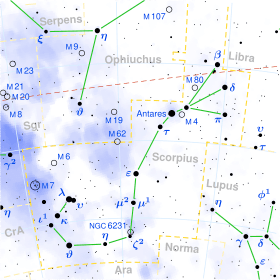4 Scorpii
 | |
| Observation data Epoch J2000.0 Equinox J2000.0 | |
|---|---|
| Constellation | Scorpius |
| Right ascension | 15h 55m 30.07935s[1] |
| Declination | −26° 15′ 57.5781″[1] |
| Apparent magnitude (V) | +5.625[2] |
| Characteristics | |
| Spectral type | A3 V[3] |
| B−V color index | 0.141±0.002[4] |
| Astrometry | |
| Radial velocity (Rv) | −29.0±1.7[5] km/s |
| Proper motion (μ) | RA: −35.80[1] mas/yr Dec.: −30.09[1] mas/yr |
| Parallax (π) | 7.99 ± 0.77[1] mas |
| Distance | 410 ± 40 ly (130 ± 10 pc) |
| Absolute magnitude (MV) | +0.17[4] |
| Details | |
| Mass | 2.64±0.08[6] M☉ |
| Luminosity | 92+22 −18[6] L☉ |
| Temperature | 8,356+97 −96[6] K |
| Rotational velocity (v sin i) | 128[7] km/s |
| Other designations | |
| Database references | |
| SIMBAD | data |
4 Scorpii is a single[8] star in the southern zodiac constellation of Scorpius. With an apparent visual magnitude of +5.6,[2] it is dimly visible to the naked eye under good viewing conditions. The distance to this star can be estimated from its annual parallax shift of 7.99±0.77 mas,[1] which yields a value of around 410 light years. It is moving closer to the Sun with a heliocentric radial velocity of −29 km/s[5] and will reach perihelion in about two million years at an estimated distance of 280 ly (86 pc).[4]
The stellar classification of 4 Scorpii is A3 V,[3] indicating this is an ordinary A-type main-sequence star. It has 2.6 times the mass of the Sun and is radiating around 92 times the Sun's luminosity from its photosphere at an effective temperature of about 8,356 K.[6]
References
- 1 2 3 4 5 6 van Leeuwen, F. (2007). "Validation of the new Hipparcos reduction". Astronomy and Astrophysics. 474 (2): 653–664. arXiv:0708.1752. Bibcode:2007A&A...474..653V. doi:10.1051/0004-6361:20078357. Vizier catalog entry
- 1 2 Høg, E.; et al. (2000). "The Tycho-2 catalogue of the 2.5 million brightest stars". Astronomy and Astrophysics. 355: L27–L30. Bibcode:2000A&A...355L..27H.
- 1 2 Houk, N.; Swift, C. (1999). "Michigan catalogue of two-dimensional spectral types for the HD Stars, Vol. 5". Michigan Spectral Survey. 5: 0. Bibcode:1999MSS...C05....0H.
- 1 2 3 Anderson, E.; Francis, Ch. (2012). "XHIP: An extended hipparcos compilation". Astronomy Letters. 38 (5): 331. arXiv:1108.4971. Bibcode:2012AstL...38..331A. doi:10.1134/S1063773712050015.
- 1 2 Gontcharov, G. A. (2006). "Pulkovo Compilation of Radial Velocities for 35 495 Hipparcos stars in a common system". Astronomy Letters. 32 (11): 759–771. arXiv:1606.08053. Bibcode:2006AstL...32..759G. doi:10.1134/S1063773706110065.
- 1 2 3 4 Zorec, J.; Royer, F. (2012). "Rotational velocities of A-type stars. IV. Evolution of rotational velocities". Astronomy & Astrophysics. 537: A120. arXiv:1201.2052. Bibcode:2012A&A...537A.120Z. doi:10.1051/0004-6361/201117691.
- ↑ Royer, F.; Grenier, S.; Baylac, M.-O.; Gómez, A. E.; Zorec, J. (2002). "Rotational velocities of A-type stars in the northern hemisphere. II. Measurement of v sin i". Astronomy and Astrophysics. 393 (3): 897–911. arXiv:astro-ph/0205255. Bibcode:2002A&A...393..897R. doi:10.1051/0004-6361:20020943.
- ↑ Eggleton, P. P.; Tokovinin, A. A. (September 2008), "A catalogue of multiplicity among bright stellar systems", Monthly Notices of the Royal Astronomical Society, 389 (2): 869–879, arXiv:0806.2878, Bibcode:2008MNRAS.389..869E, doi:10.1111/j.1365-2966.2008.13596.x.